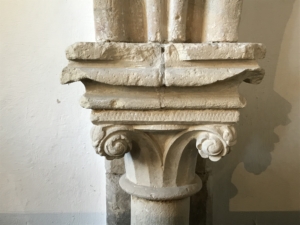All Saints & St Nicolas in Icklesham
Icklesham parish is the older of the two parishes within the benefice of Winchelsea with Icklesham.
Parish Eucharist following Common Worship, including hymns, is celebrated on the second and fourth Sundays of each month at 9:30am.
Worship on this site in Icklesham almost certainly goes back to Anglo-Saxon times.
A charter from the eighth century records a gift of land by Offa King of Mercia to the bishops of Selsey.
“Let the aforesaid land remain from this day, given as I have said for me in the name of God, free from all royal exactions and bound to the use of those serving God, but on this condition: that after his day (Bishop Oswald) this gift be returned to the Episcopal see which is called Selsey. If anyone at any time in great or small degree dares to reduce this gift, made by me, let him know that he will incur the penalty for his presumption in the stern judgement of the all-powerful God, and will not escape from a bad hearing… I. Offa, King of the Mercian’s as the power was conceded to me by God who reigns, have confirmed this gift, signing it with my own hand and placed the sign of the holy cross.”
We are privileged to continue to offer prayer and praise here, now in the diocese of Chichester.
The oldest church in the benefice has a rich history and a strong association with our French and Norman neighbours.
Icklesham means the homestead or enclosure of Icel, a relatively common Saxon name. The church was originally dedicated to All Saints, which was common in the Norman period, but it was changed by Henry VIII to St Nicolas. Nicolas is associated with protecting mariners, appropriate as Icklesham was still coastal at the time (and of course with Santa Claus). Why the French spelling was adopted is not clear. In the 19th Century the Rev H.B.W.Churton revived the original dedication but the south chapel is still dedicated to St Nicolas.
It was not until after the destruction of the old port of Winchelsea and the establishment of the present town that the new parish of Winchelsea was established by Edward I in 1288. Much of the original parish of Icklesham was assigned to the new town. This accounts for the fact that the parish boundary of Icklesham extends around the northern and eastern boundaries of Winchelsea parish.
It is thought that there has been a church on the site since Canute’s reign, although it is not referred to in any historical documents. The area was under the control of the Abbey of Fécamp in Normandy before the Norman Conquest and this may explain why the parish does not appear in Domesday Book.
When William landed at Pevensey Bay in late September 1066, one of the first things he did was to seize and secure the Hastings Peninsula; the high ground between the Channel and the tidal inlet of the River Brede to the north, now farmland. Icklesham was in a commanding position with good views north and south and access to the sea. The church as it is now with its Norman columns must have been built in the years immediately after the conquest.
Like most churches, All Saints & St Nicolas has been altered and added to over the years.
Part of the west wall show signs of the earliest church, which certainly dates from the early Norman period if not before. On entering the church, the most striking features are the magnificent nave pillars and arches which are typical of Norman church architecture. Within the chancel arch and the North Chapel, now adapted as the vestry, there are lancet arches dating from the early 13th century.
The South or ‘Manor’ Chapel includes an arcade dating from a little later and is a good example of the transitional period between early pointed and geometrical English work. The stone is Caen stone of the highest quality imported from France and indicative of the strong links between England and France at that time.

Finely carved 14th century capital in Caen stone
On close inspection can be seen that the chancel columns do not line up directly with those in the nave. The church seems to be slightly askew. This is not an architectural error but an intentional feature often referred to as a ‘weeping chancel’. The asymmetrical outline is intended to represent Christ in agony as his body leans to one side during the crucifixion.
If you take the time to examine the large Norman columns in the nave, rather crudely engraved crosses can be seen. They were carved by pilgrims on their way to Santiago da Compostela along the celebrated Way of St James (now more frequently referred to as the Camino and undergoing a considerable revival). They remind us that Icklesham was on the road to ports offering a route through France or northern Spain.
In most other respects the church would seem largely unchanged to anyone who had known it around 1400. However, the exterior was restored in the 19th century by the celebrated architect S S Teulon, when the porch was added and the clerestory to the north of the nave was restored. The carved foliate corbels in the nave date from this period.